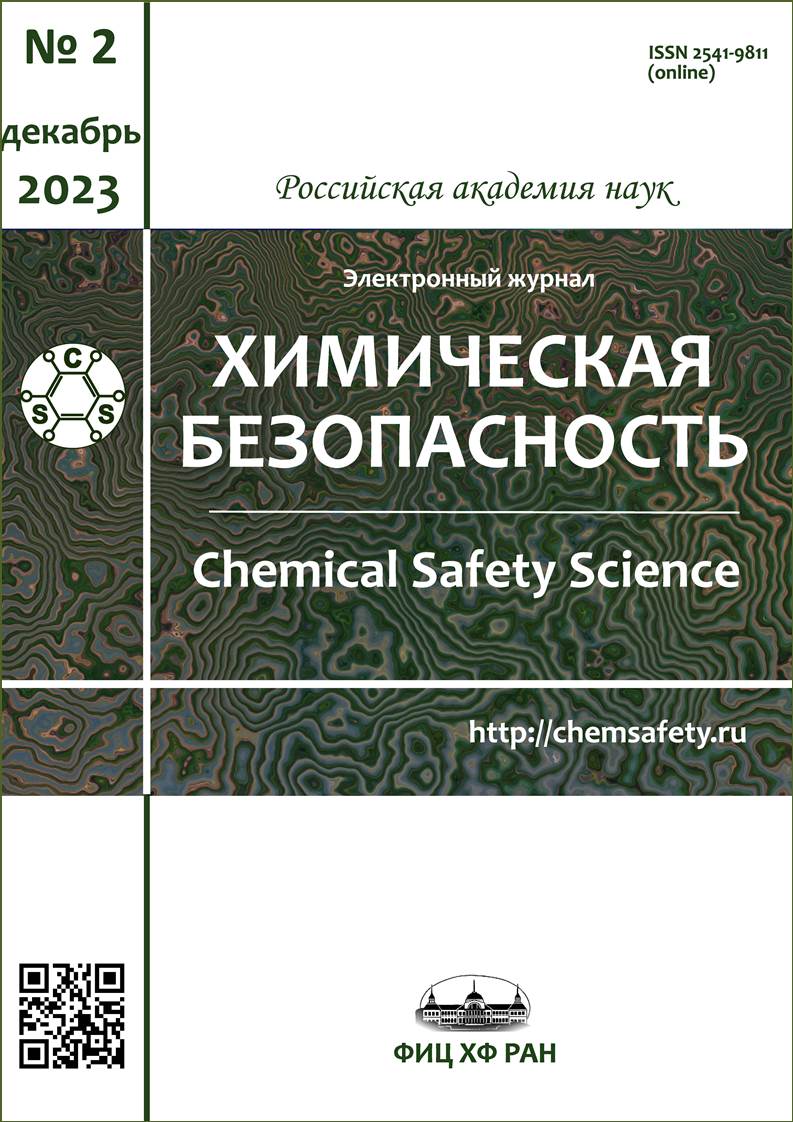Инновационные технологии ликвидации последствий разливов нефти адсорбционным разделением нефти и воды. Обзор
Аннотация
Abstract - The transportation of crude and refined oil by land and sea includes the facts of the risk for the emergence of one of the sources of pollution of our planet, which is a consequence of an oil spill. The preservation of the ecological stability of the environment can be ensured by reducing the risk of accidents, as well as technologies that eliminate their consequences. The article discusses the proposed new technologies over the past three years regarding the adsorption separation of oil and water, which contribute to the elimination of the consequences of oil spills, including in water areas. The achievements of recent years regarding the choice of modifying agents, as well as the modification conditions that provide an increase in the adsorption capacity of the obtained composites, are presented. Composite materials are presented, obtained by modifying traditional adsorbents, endowed with such properties as superhydrophobicity, resistance to biological decomposition, buoyancy, and the possibility of repeated use. The individual advantages of sorbents, which are composite sponges, membranes, aerogels, hydrophobic paper, films of their polymeric microspheres and magnetic composites, are noted.
Литература
Yang Z., Chen Z., Lee K., Owens E., Boufadel M.C., An C., Taylor E. (2021). Decision support tools for oil spill response (OSR-DSTs): Approaches, challenges, and future research perspectives. Marine Pollution Bulletin. 167:112313–112328. https://doi.org/10.1016/j.marpolbul.2021.112313.
Gizatullin B., Papmahl E., Mattea C., Stapf S. (2021). Quantifying Crude Oil Contamination in Sand and Soil by EPR Spectroscopy. Appl. Magn. Reson. 52, 633–648. https://doi.org/10.1007/s00723-021-01331-4.
Black death of the planet https://plus-one.ru/ecology/2020/06/05/chernaya-smert-planety
Reza Behnood, Bagher Anvaripour, Nematollah Jaafarzade, Haghighi Fard, Masoumeh Farasati. (2013). Application of Natural Sorbents in Crude Oil Adsorption. Iranian Journal of Oil & Gas Science and Technology, 2(4), 1–11. https://doi.org/10.22050/ijogst.2013.4792
Zunaira Asif, Zhi Chen, Chunjiang An, Jinxin Dong. (2022). Environmental Impacts and Challenges Associated with Oil Spills on Shorelines. J. Mar. Sci. Eng. 10(6); 762. https://doi.org/10.3390/jmse10060762
Zakaria, N.N.; Convey, P.; Gomez-Fuentes, C.; Zulkharnain, A.; Sabri, S.; Shaharuddin, N.A.; Ahmad, S.A. (2021). Oil bioremediation in the marine environment of antarctica: A review and bibliometric keyword cluster analysis. Microorganisms , 9, 419. https://doi.org/10.3390/microorganisms9020419
Поведение морских разливов нефти. Технический информационный документ. https://www.itopf.org/fileadmin/uploads/itopf/data/Documents/TIPS_TAPS_new/TIP_2_2011_RU_FINAL.pdf
Pat. 106986416, China, 2017.
Li L., Li H., Qu C. (2019). A Review of the Mechanism of Microbial Degradation of Petroleum Pollution // Materials Science and Engineering. 484. Article ID 012060. https://doi.org/10.1088/1757-899X/484/1/012060
Panagiotis G., Matteo D., Andrea F., Jonathan D.V.H., Hamme W.S., Jaco V. (2016). The Interaction between Plants and Bacteria in the Remediation of Petroleum Hydrocarbons: An Environmental Perspective. Frontiers in Microbiology. 7. Article ID 1836. P. 1–27. https://doi.org/10.3389/fmicb.2016.01836
Noor Al-Jammal, TatjánaJuzsakova. (2017). Review on the effectiveness of adsorbent materials in oil spills clean up. Proceedings of 7th International Conference of ICEEE, 17–19 of November 2016, Budapest, Hungary. P. 131–137. ISBN 978-963-449-063-0.
Pat.112642406, China, 2021
Pat.113756127, China, 2021.
Sippel I., Akhmetgaleeva G. A., Magdin K.A. (2021). Removal of oils from water surfaces with modified Linden sawdust. AGRITECH-IV-2020 IOP Conf. Series: Earth and Environmental Science 677, 1–5. 052016 IOP Publishing https://doi.org/10.1088/1755-1315/677/5/052016
Pat. 2025891, Netherlands, 2021
Pat. 114874531, China, 2022.
Pat. 112090295, China, 2022.
Pat. 20200197878, USA, 2022
Panchan Dansawad, Yujie Yang, Xin Li, Xiaopeng Shang, Yanxiang Li, Zhiwei Guo,Yashiqing, Shengyong Zhao, Siming You, Wangliang Li. (2022). Smart membranes for oil/water emulsions separation: A review. Advanced Membranes. 2, 100039 https://doi.org/10.1016/j.advmem.2022.100039
Guoliang Liu, Yahui Cai, Hongye Yuan , Jinliang Zhang, Zunmin Zhang, Dan Zhao. (2023). Mesh membranes coated with zirconium metal-organic framework nanosheets of optimized morphology for oil-water separation. Journal of Membrane Science. 668, 121077. https://doi.org/10.1016/j.memsci.2022.12107
Pat. 114452956, China, 2022
Pat. 111686478, China, 2022
Pat. 20210121831, USA, 2020
Santamaria-Echart A., Fernandes I., Barreiro F., Corcuera M.A., Eceiza A. (2021). Advances in Waterborne Polyurethane and Polyurethane-Urea Dispersions and Their Eco-friendly Derivatives: A Review. Polymers. 13:409. https://doi.org/10.3390/polym13030409
Zhi Chien Ng, Rosyiela Azwa Roslan, Woei Jye Lau, Mehmet Gürsoy, Mustafa Karaman, Nora Jullok, Ahmad Fauzi Ismail. ( 2020) A Green Approach to Modify Surface Properties of Polyuretha Foam for Enhanced Oil Absorption. Polymers (Basel). 12(9): 1883. https://doi.org/10.3390/polym12091883
Seung Mo Kong, Youngbae Han, Nam-Il Won, Yang Ho Na. (2021). Polyurethane Sponge with a Modified Specific Surface for Repeatable Oil–Water Separation. ACS Omega. 6(49), 33969–33975. https://doi.org/10.1021/acsomega.1c05301
Rangabhashiyam Selvasembian, Willis Gwenzi, Nhamo Chaukura, Siyanda Mthembu. (2021).Recent advances in the polyurethane-based adsorbents for the decontamination of hazardous wastewater pollutants. Journal of Hazardous Materials. 417, 125960 https://doi.org/10.1016/j.jhazmat.2021.125960
Pat.114752104, China, 2022
Pat.113754922, China, 2022
Pat.114561039, China, 2022
Pat.114949933, China, 2022
Pat.114262410, China, 2022
Pat. 113073466, China, 2022
Pat. 2020063375, Japan, 2020
Soliman E.M, Ahmed S.A, Fadl A.A. (2020). Adsorptive removal of oil spill from sea water surface using magnetic wood sawdust as a novel nano-composite synthesized via microwave approach. J Environ Health Sci Eng. Jun. https://doi.org/10.1007/s40201-019-00440-4
Copyright (c) 2023 Р.А. Исмайлова, Е.Н. Алиев, С.А. Герайбейли

Это произведение доступно по лицензии Creative Commons «Attribution-NonCommercial» («Атрибуция — Некоммерческое использование») 4.0 Всемирная.









